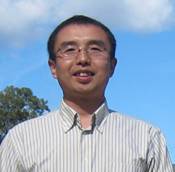Search

State Key Laboratory of Pollution Control and Resource Reuse
Key Laboratory of Yangtze Aquatic Environment, Ministry of Education of China
College of Environmental Science and Engineering, Tongji University, 200092, Shanghai, China
Tel: +86 21 6598 5116, Fax: +86 21 6598 5059, Mobile: +86 159 2126 0028
Email: rongchang.wang@gmail.com, wangrongchang@tongji.edu.cn
Dr. Rongchang Wang is currently an associate professor in College of Environmental Science and Engineering, Tongji University, Shanghai. He got his Ph.D. degree from Tsinghua University in 2005. Since then, he was employed by Tongji University and has been actively engaging in education and research on water pollution control and water reuse, specifically within development of novel bioreactors for wastewater treatment and reuse, such as some membrane bioreactors and biofilm reactors, and their design and implementation in urban and rural areas in China. He conducted his postdoc research in Technical University of Denmark from 2007 to 2008. He is currently a management board member of IWA Specialist Group on Water Reuse (SGWR) and the leader of Young Water Professionals in IWA SGWR. He is also a board member of IWA China Young Water Professionals National Committee.
◆Education Experience
March 2000 - January 2005 Department of Environmental Science and Engineering, Tsinghua University, Beijing, China. PhD candidate in Environmental Engineering
September 1997 - March 2000 College of Environmental Science and Engineering, Tongji University, Shanghai, China. Master of Engineering Science in Municipal Engineering
September 1992 - July 1996 Department of Environmental Engineering, Qingdao Technological University, Qingdao, China. Bachelor of Engineering in Environmental Engineering
◆Awards and Honors
First Class Award of Scientific and Technological Achievement Prize on Environmental Protection of China, 2006
Marie Curie International Incoming Fellowship (2008-2010), European Union Commission.
DANIDA Fellowship, 2006
CITIC Postgraduate Award, Tsinghua University, 2004
Guanghua Postgraduate Award, Tsinghua University, 2003
Award for Excellent Social Practice, Tsinghua University, 2001
Outstanding Graduate Award, Tongji University, 1999
Zongzhuozhang Award, Qingdao Technological University, 1994-1995
Award for Excellent Undergraduate Students, Qingdao Technological University, 1993-1995
◆Working Experience
March 2007 – present Postdoc., Assistant Research Professor Institute of Environment and Resources, Technical University of Denmark
February 2005 - February 2007, Lecturer, College of Environmental Science and Engineering, Tongji University
August 1996 - August 1997, Project Manager, Shanghai Tongji Environmental Protection Ltd.]
◆Publications (Selected):
[1]Wang RC, Terada A, Smets BF, Henze M, Xia SQ, Zhao JF. (2009) Nitritation performance and biofilm development of co- and counter-diffusion biofilms: modeling and experimental comparison. Water Research. 43(10):2699-2709.
[2]Wang RC, Ren DJ, Xia SQ, Zhang YL, Zhao JF. (2009) Photocatalytic degradation of Bisphenol A (BPA) using immobilized TiO2 and UV illumination in a horizontal circulating bed photocatalytic reactor (HCBPR). Journal of Hazardous Materials.169:926-932.
[3]Wang RC, Zhan XM, Zhang YL, Zhao JF. (2011) Nitrifying Population Dynamics in a Redox Stratified Membrane Biofilm Reactor (RSMBR) for Treating Ammonium-rich Wastewater. Frontiers of Environmental Science & Engineering. 5(1):48-56.
[4]Wang RC, Tong H, Xia SQ, Zhang YL, Zhao JF. (2010) Bisphenol A removal by combination of powdered activated carbon adsorption and ultrafiltration. American Institute of Physics AIP Conference Proceedings, (CP1251, Second International Symposium on Aqua Science, Water Resource, and Low Carbon Energy), 2010, 1251, 101-104.
[5]Xia SQ, Li J, Wang RC, Li J and Zhang Z. (2010) Tracking composition and dynamics of nitrification and denitrification microbial community in a biofilm reactor by PCR-DGGE and combining FISH with flow cytometry. Biochemical Engineering Journal. 49(3):370-378.
[6]Xia, SQ, Guo, JF, Wang, RC (2008) Performance of a pilot-scale submerged membrane bioreactor (MBR) in treating bathing wastewater, Bioresource Technology, 99(15): 6834-6843.
[7]Guo, JF, Xia, SQ, Wang, RC, Zhao JF. (2008) Study on Membrane Fouling of Submerged Membrane Bioreacator (MBR) for Treating Bathing Wastewater. Journal of Environmental Sciences. 20:1158–1167.
[8]Xia, SQ, Li, JY, Wang, RC (2008) Nitrogen removal performance and microbial community structure dynamics response to carbon nitrogen ratio in a compact suspended carrier biofilm reactor. Ecological Engineering, 32: 256-262.
[9]Ren DJ, Wang RC, Xia SQ (2008) Preparation and photocatalystic degradation activity of TiO2 films formed by microwave assisted liquid phase deposition. Rare Metal Materials and Engineering. 37 (6): 989-994.
[10]Ren DJ, Wang, RC, Xia SQ (2007) Photocatalytic Degradation of Bisphenol A in Horizontal Circulating Bed Photocatalytic Reactor (HCBPR), Progress in Environmental Science & Technology, 2007, 1: 951-957.
[11]Guo JF, Wang, RC, Xia SQ (2007) Screening a High Effective Lineal Alkylbenzene Sulphonates (LAS) Degradation Strain, Progress in Environmental Science and Technology, 2007, 1: 886-890.
[12]Wang RC, Wen XH and Qian Y (2006) Microbial population structure changes in a suspended carrier biofilm reactor. Water Science & Technology, 54(9):145-153.
[13]Wang RC, Wen XH and Qian Y (2005) Influence of carrier concentration on performance and microbial characteristics of a suspended carrier biofilm reactor. Process Biochemistry. 40: 2992-3001.
[14]Wang RC, Wen XH and Qian Y (2004) Succession of aquatic microbial communities as a result of the water quality variations in a continuous water. Journal of Environmental Sciences-China, 2004, 16(5): 772-778.



